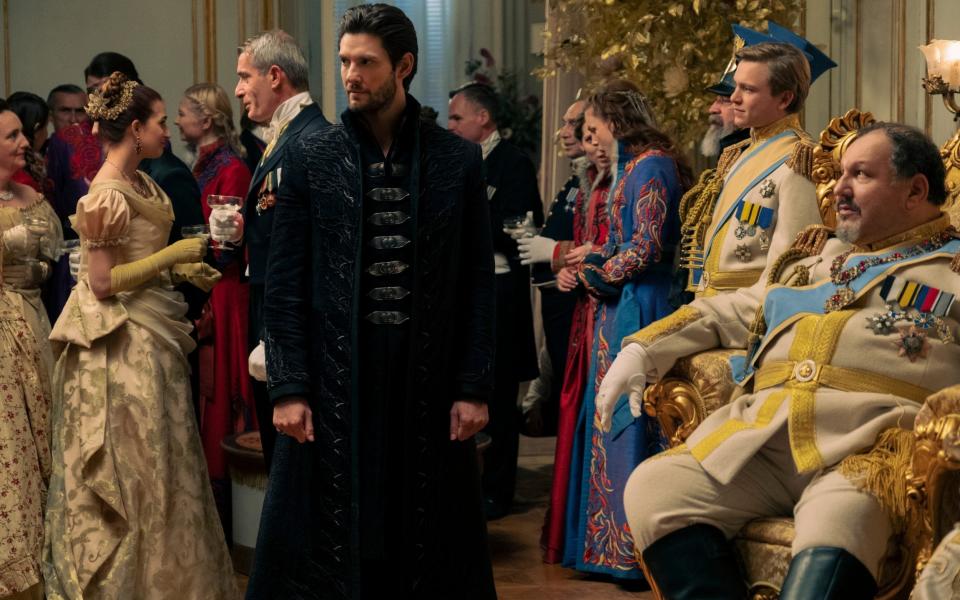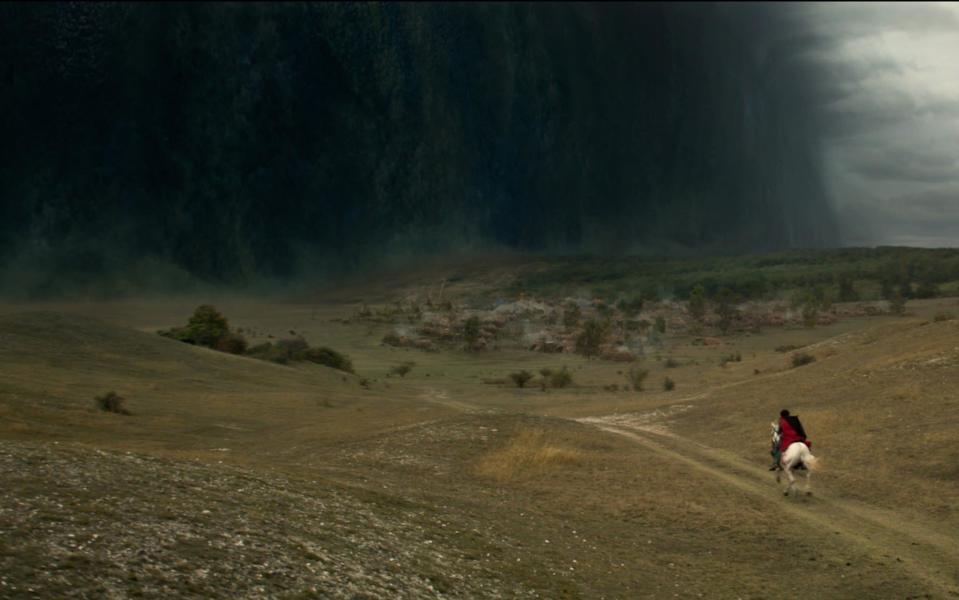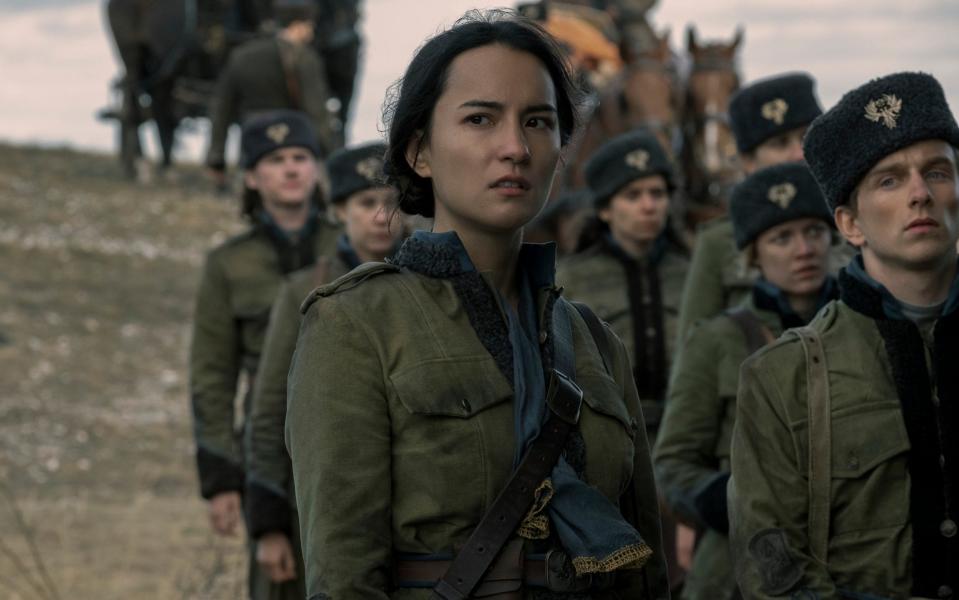We're not in Westeros anymore – inside Shadow and Bone, Netflix's GoT killer

About five minutes into Netflix’s new fantasy series, Shadow and Bone, it starts to become clear we’re a long way from Westeros, Hogwarts or Middle Earth. The first clue is the group of soldiers walking through an encampment with 19th century-style repeating rifles slung over their shoulders. Shortly afterwards, heroine Alina Starkov steps into the frame, the camera focusing on her olive-hued military uniform. The look is closer to the Battle of Kursk than of the Bastards.
Shadow and Bone, adapted from the novels by Leigh Bardugo and coming to Netflix Friday April 23, is fantasy, without question. The first episode concludes with Alina (Jessie Mei Li) fending off winged monstrosities that are a cross between Tolkien’s Ringwraiths and Pterosaurs with anger management issues. You don’t get more fantasy than that, short of having Gandalf pop up and say “speak friend and enter” or late-period Jon Snow grumbling “I don’t want it” before mooching off.
The twist is that the setting is inspired by pre-Revolutionary Tsarist Russia and by Renaissance Amsterdam. Broadswords, chainmail and Henry VIII lookalikes chomping chicken legs in medieval banqueting halls are nowhere to be seen.
Alina, a humble cartographer in the First Army of Ravka (i.e. fantasy Russia) is about to make a perilous journey with her company across a void known as the Shadow Fold. When flying beasts attack, she discovers she has rare magical powers – which she uses to fight off the creatures. The incident brings her to the attention of the mysterious General Kirigan (Ben Barnes), who takes her to the imperial capital, Os Alta, where she is to be trained as a magic-wielder.
Torn from the only life she knows, orphan Alina fears she may never again see childhood friend Mal (Archie Renaux). And half a world a way, word of her abilities has reached the criminal underworld of Ketterdam (fantasy Amsterdam). And with that we are off to the races.
Shadow and Bone’s opening credits do not feature the sort of clockwork map which, in Game of Thrones, served as a shorthand introduction to the world we were about to visit. But if they did, we would swoop from the island of Kerch, with its capital of Ketterdam, in the south, over the Wandering Isle (Bardugo’s version of Ireland) and then to Ravka. To the south and east would lie Shu, based on Mongolia and China.
And there would be a dark blot streaked across the middle, dividing Ravka in two. This is the “Shadow Fold” – a broiling sea of darkness splitting the Empire and stalked by terrifying flying monsters, the Volcra (those Ringwraith/Pterosaur hybrids). To travel from one side of Ravka to the other you must cross this hellscape, with the ever-present possibility of encountering monsters beyond one’s darkest nightmares.
Another distinguishing factor from Game of Thrones and Tolkien is that in Shadow and Bone magic is a part of everyday life, with widely-understood rules and conventions. Its practitioners are known as “Grisha” – Bardugo's books are collectively referred to as the “Grishaverse” – and fall into distinct categories.

Alina, we soon discover, is an Etherealki, meaning she can channel the elements (a bit like the characters in Avatar: The Last Airbender). Later, in Ketterdam, we meet Nina, a Corporalki “heartrender” able to manipulate the bodies of her enemies, slowing their pulses or even crushing windpipes. She can also heal if required – though true her talent is in ripping flesh rather than stitching it together.
But if the Grisha are powerful they are not universally beloved. Decades previously they were persecuted as witches. And they are still looked on with suspicion.
Yet it’s the technological advancement that may initially jar with viewers who associate fantasy with the Middle Ages. “If the story were set in our world, the time period would be closest to the early 1800s. In terms of military technology, you see sabers, muskets, and most importantly, the advent of the repeating rifle,” Bardugo explained when the first Shadow and Bone novel was published in 2012.

There are, in all, seven Grishaverse books, beginning with the Shadow and Bone trilogy in 2012. This was followed by two Six of Crows novels and then by the two-part King Of Scars series. There are also a number of short story anthologies and reference volumes.
Shadow and Bone the series isn’t, it should be noted, a straight adaptation of the first novel in the sequence, as Game of Thrones season one was of the book A Game Of Thrones. If relatively true to the original plot, it doubles as prequel to Six of Crows, by introducing us to The Dregs, a gang of street urchins each with unique abilities. It’s a two for-one-deal, which faithfully transposes the first Grishaverse story while setting up a season devoted to the events of Six of Crows.
Unlike Game of Thrones and Middle Earth, Shadow and Bone doesn’t shy away from interrogating social issues. General Kirigan (The Darkling in the books) could be viewed as a metaphor for toxic masculinity (he even dresses all in black). In the show, Alina is of mixed race, with one parent from Shu, one from Ravka. This is a device for exploring racial prejudice and giving Alina an outsider’s perspective even as she serves on the frontline in Ravka’s First Army.

“I don’t really set out to tells a story with a specific message or to say I’m going to tackle toxic masculinity or racism or rape culture,” Bardugo explained recently. “But if you want to tell a story and if you want it to feel real, then you have to be thoughtful about these things. To disregard them or ignore them I think feels false.
“Readers pick up on that pretty quickly. In Six of Crows I set out wanting to write this Ocean’s Eleven-in-a-fantasy world style heist. But you can’t write a story about thugs and thieves without exploring the forces that created those thugs and thieves. For me, it’s about telling that story as truly and completely as possible.”
Which leaves only big question. Who are the baddies? Ravka is at war with Fjerda, a sort of expansionist greater Scandinavia where Grisha are regarded as aberrations. Their holy soldiers, the Drüskelle , are trained to kill magic users on sight. However, as Alina soon discovers the real enemies are perhaps closer to home and pose a threat far greater than all the armies of the Grishaverse combined. Watching her tease out this puzzle is one of the thrills of a series which feels nothing like Game of Thrones or Lord of the Rings – but rather has a magic all of its own.
Shadow and Bone begins today, April 23 on Netflix

